Embedded servers have PC/104 SBCs inside
Nov 17, 2009 — by LinuxDevices Staff — from the LinuxDevices Archive — 12 viewsDiamond Systems announced a series of “embedded application servers” based on previously released PC/104 SBCs (single board computers). The Octavio-HLV and Octavio-ATHM run Linux 2.6 on 800MHz Vortex86DX or 500MHz Via Mark CoreFusion processors, respectively, include cableless construction, and sport soldered-on memory, the company says.
Diamond's ingenious Octavio products leverage the company's previously released PC/104 SBCs and enclosure systems, creating compact "embedded application servers" that are touted as being operable "from the Arctic to the Sahara, and even in outer space." Operating range for the fanless devices is -40 to 185 deg. F (-40 to 85 deg. C), there are no cables to come loose, and the systems' 256MB of memory is soldered down, according to the company.
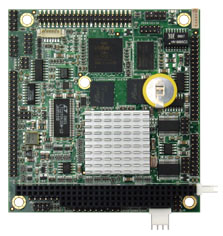 As Diamond explains, the Octavio-HLV is based on the company's Helios SBC (right), which employs the 800MHz Vortex86DX that was announced last year. Unlike DMP's later Vortex86MX, the Vortex86DX does not include graphics, but Diamond has apparently added VGA capabilities by using XGI's Volari Z9s graphics chipset.
As Diamond explains, the Octavio-HLV is based on the company's Helios SBC (right), which employs the 800MHz Vortex86DX that was announced last year. Unlike DMP's later Vortex86MX, the Vortex86DX does not include graphics, but Diamond has apparently added VGA capabilities by using XGI's Volari Z9s graphics chipset.
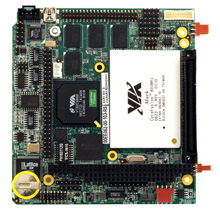 The Octavio-ATHM, meanwhile, is based on Diamond's Athena II SBC (left), which employs a 500MHz Via Mark CoreFusion chipset. Introduced in 2005, this chipset (see block diagram, here) combined Via's embedded Eden core with the company's CLE266 northbridge and an ISA bus.
The Octavio-ATHM, meanwhile, is based on Diamond's Athena II SBC (left), which employs a 500MHz Via Mark CoreFusion chipset. Introduced in 2005, this chipset (see block diagram, here) combined Via's embedded Eden core with the company's CLE266 northbridge and an ISA bus.
(At the time, in an interview with LinuxDevices.com editor-in-chief Rick Lehrbaum, who now happens to be executive VP of strategic development for Diamond Systems, Via's Glenn Henry astutely predicted that most x86 processors would eventually include built-in graphics.)
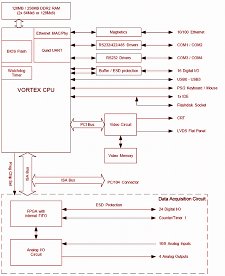
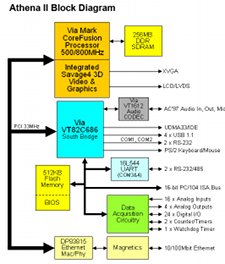
Block diagrams for the Diamond Helios (left) and Athena II (right) SBCs
(Click to enlarge)
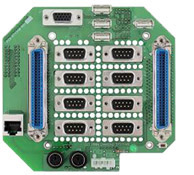 To create the Octavio systems, Diamond places the Helios or Athena II inside its Pandora, a metal enclosure that comes with a panel I/O board similar to the one shown at right. The Pandora case is offered in four lengths, described by the company as follows:
To create the Octavio systems, Diamond places the Helios or Athena II inside its Pandora, a metal enclosure that comes with a panel I/O board similar to the one shown at right. The Pandora case is offered in four lengths, described by the company as follows:
- A 1.7 inch (43.18mm) case accommodates the SBC, the panel I/O board, and an optional notebook hard drive
- A 3.0 inch (76.2mm) case accommodates the SBC, panel I/O board, up to two additional PC/104 boards, and the optional notebook hard drive
- A 5.0 inch (127mm) case accommodates the SBC, panel I/O board, up to five additional PC/104 boards, and the optional hard drive
- A 7.0 inch (178mm) case accommodates the SBC, panel I/O board, up to seven additional PC/104 boards, and optional hard drive
Even in the 1.7-inch version, the Octavio-HLV and Octavio-ATHM are available with an optional built-in data acquisition subsystem, providing 16 16-bit A/D channels with up to 100KHz data conversion rate, 512- or 2048-sample FIFO (depending on model), and autocallibration for maximum accuracy, according to Diamond. The DAQ subsystem is additionally said to provide: 4 12-bit analog outputs; 16, 24, or 40 digital I/O lines (depending on model); and counter/timer functions for sample rate control or general purpose timing.
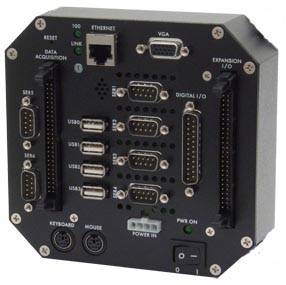
Diamond Systems' Octavio
Identical in external appearance, the Octavio-HLV and Octavio-ATHM both include RJ45 connectors for 10/100 Ethernet, VGA outputs, four USB ports, four serial ports (2 RS232, 2 RS232/485), and dual PS/2 ports. The devices also offer expansion connectors, power switches, and exposed screwheads that would allow for easy disassembly, Diamond says.
Both computers have 256MB of soldered-down memory and can support notebook hard disk drives. Diamond offers the alternative of 128MB or 1GB IDE flash drives for the Octavio-HLV, and 512MB or 4GB flash drives for the Octavio-ATHM.
As relative clock speeds and processor introduction dates imply, the Octavio-HLV is likely the faster of the two systems — though Diamond itself merely characterizes both as "mid-performance" — and supports USB 2.0 instead of the Octavio-ATHM's USB 1.1. Display resolution, however, is said to be higher on the ATHM, which is rated for 1600 x 1200 pixels instead of the HLV's 1280 x 1024.
Both devices are offered with Linux 2.6, including the Grub version 0.97 boot loader, 2.6.23 kernel-based image, root file system, GCC version 3.2.3, BusyBox version 1.10.4, and a text-only interface. The Octavio-ATHM is also available with QNX, according to Diamond. The Octavio-HLV, meanwhile, is additionally offered with a preinstalled, bootable Windows CE 6.0 image, and a BSP (board support package).
Features and specifications cited by Diamond for the Octavio-HLV and Octavio-ATHM include the following:
- Processor:
- Octavio-HLV — 800MHz DMP Vorte86DX
- Octavio-ATHM — 500MHz Via Mark CoreFusion
- Memory — 256MB of soldered DRAM
- Storage:
- Octavio-HLV — 128MB or 1GB IDE flash drive, or notebook hard drive
- Octavio-ATHM — 512MB or 4GB IDE flash drive, or notebook hard drive
- Expansion — PC/104; optional data acquisition subsystem
- Networking — 10/100 Ethernet
- Other I/O:
- 1 x VGA
- 2 x PS/2
- 4 x USB (2.0 on Octavio-HLV; 1.1 on Octavio-ATHM)
- 4 x serial (2 x RS232; 2 x RS232/485)
- Power requirements:
- Octavio-HLV — 5VDC; 5 watt maximum
- Octavio-ATHM — 5VDC — 10 Watt maximum
- Operating temperature — -40 to 185 deg. F (-40 to 85 deg. C)
- Dimensions:
- Footprint — 5/75 x 5.5 inches (145 x 138mm)
- Height — 1.7, 3, 5 or 7 inches
- Weight:
- Octavio-HLV — 28.6 ounces (810.8g)
- Octavio-ATHM — 30.4 ounces (861.8g)
Availability
According to Diamond Systems, pricing for the Octavio systems, which appear to be available now, is lower than $550 apiece in volume. Quantity one pricing starts at $605 for the Octavio-HLV and $940 for the Octavio-ATHM, the company says.
More information on the Octavio devices may be found on the Diamond Systems website, here. Product pages for the underlying Helios and Athena II SBCs, meanwhile, may be found here and here respectively.
This article was originally published on LinuxDevices.com and has been donated to the open source community by QuinStreet Inc. Please visit LinuxToday.com for up-to-date news and articles about Linux and open source.